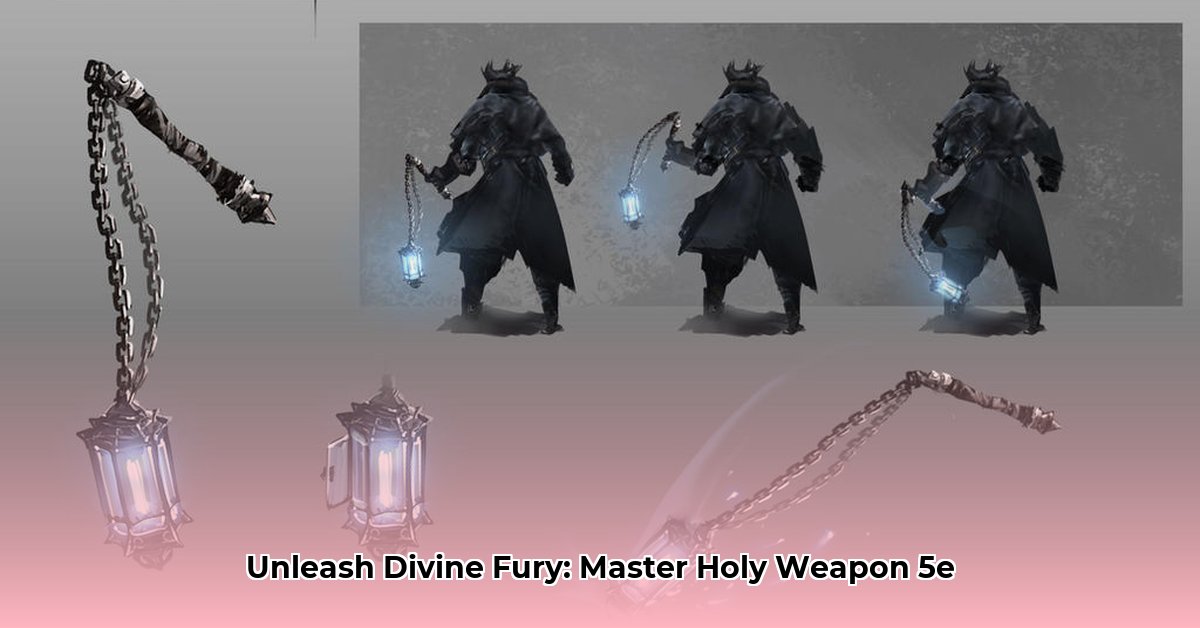Want to amplify your D&D character’s power? The Holy Weapon spell offers incredible radiant damage and the ability to blind enemies. This guide provides all the information needed to effectively utilize the spell, from damage maximization to common pitfalls. We’ll analyze damage mechanics, strategic blinding tactics, and concentration maintenance. We will also discuss how it compares to other powerful spells in order to help players determine the best approach. This guide has tips and tricks for clerics, paladins, and Dungeon Masters alike, unleashing the full power of Holy Weapon. Prepare for divine devastation!
Holy Weapon 5e: Mastering Radiant Damage & Blindness
Looking to master the Holy Weapon 5e spell? You’ve made a great choice. This potent 5th-level spell can dramatically change combat, significantly improving your attacks and providing tactical advantages. Let’s explore the details and unleash its potential by unlocking the radiant damage.
Unleashing the Divine Power of Holy Weapon
Imagine a goblin horde approaching. After casting Holy Weapon, your sword, axe, or even a slingshot now glows with divine energy. Every hit delivers extra radiant damage, and you can unleash a blinding burst, allowing for tactical brilliance. Holy Weapon isn’t just about raw power; it’s about intelligent tactics.
Radiant Damage: Supercharged Strikes
The core of Holy Weapon is enhanced damage. Each attack made during the spell’s duration gains an additional 2d8 radiant damage on a hit. This is a substantial increase, particularly effective against creatures vulnerable to radiant damage, such as undead. Its scaling is highly beneficial, especially for characters who attack multiple times each turn, such as Fighters utilizing the Extra Attack feature. But how does this work against various enemy types?
Let’s examine some specific damage examples, using an average roll of 4.5 on a d8 (since a d8 averages between 1 and 8):
| Attacks per Round | Average Radiant Damage per Attack | Total Added Radiant Damage per Round |
|---|---|---|
| 1 | 9 | 9 |
| 2 | 9 | 18 |
| 3 | 9 | 27 |
| 4 | 9 | 36 |
As the table indicates, the additional radiant damage grows significantly with each attack landed. As such, Holy Weapon is particularly effective against numerous weaker enemies or single, powerful targets with low armor classes. Consider targeting undead creatures, as they are often vulnerable to radiant damage.
The Blinding Burst: Tactical Brilliance
There’s more to Holy Weapon than sheer damage output. Beyond increased damage, it offers significant battlefield control. As a bonus action, you can dismiss the spell and release a blinding burst of radiant energy in a 30-foot radius, centered on your weapon. Enemies within this area must make a Constitution saving throw (DC equals 8 + your spellcasting ability modifier + your proficiency bonus) or become blinded for 1 minute. A blinded creature repeats the saving throw at the end of each of its turns, ending the effect on itself on a success.
Blinded creatures suffer disadvantage on attack rolls and attack rolls against them have advantage, making them less likely to target you and more vulnerable to your allies. This can provide critical openings for your allies and allow you to focus fire on other threats. Think of the blinding burst as a means of temporarily disabling enemies, giving your team a crucial tactical advantage. Using it to incapacitate a dangerous enemy spellcaster before they can unleash a powerful spell, or to provide cover for a retreating ally, demonstrates smart usage of this ability.
Concentration: The Lingering Catch
This powerful spell requires concentration, meaning the spell’s effect can be disrupted by taking damage, potentially costing you the extra damage and blinding burst, creating a vulnerability. To mitigate this, consider enhancing your Armor Class (AC) through equipment or spells like Shield of Faith. Cast defensive spells like Shield when anticipating a heavy attack, and position yourself strategically to avoid taking hits in the first place. Evaluate the risk versus reward before entering a dangerous situation. War Caster is also an excellent feat choice for those who want to improve their ability to maintain concentration.
Resource Management: Weighing the Divine Cost
Holy Weapon is a 5th-level spell, requiring careful consideration before casting. It consumes a valuable spell slot, so assess the situation before committing. Factors to consider include: Is the enemy heavily armored (potentially reducing the effectiveness of the added radiant damage)? Are you battling multiple enemies where the blinding burst could dramatically shift the battle’s momentum? Other spells, like Flame Strike, might prove more effective against clustered, heavily armored foes. Strategic spell slot usage is essential for any spellcaster, and Holy Weapon is no exception.
Players might choose other 5th-level spells, depending on the specific encounter. Balance the sustained damage boost and potential of blinding burst against the possibility of losing concentration and the opportunity cost of using a different spell. Every situation is unique and calls for careful evaluation.
Nuances and Clarifications: The Fine Print of Divinity
Several important points to remember regarding Holy Weapon:
- Ammunition: Ranged weapon ammunition is magically enhanced by Holy Weapon, inflicting the additional radiant damage on each successful hit. However, this spell is incompatible with unarmed strikes and natural weapons, as it requires a weapon to function.
- Twinned Spell?: Holy Weapon cannot be twinned, as it affects a single weapon and, by extension, the wielder’s attacks.
- Burst Range: Officially, the burst originates from your weapon. However, questions can arise regarding its exact area of effect, especially in three-dimensional spaces. Discuss precise interpretations and applications with your Dungeon Master to ensure clarity and consistency.
Discuss rule interpretations with your Dungeon Master before play. Ensure consistent application and a clear understanding amongst all players to avoid confusion or disputes during gameplay.
Optimization Strategies: Tips for Players and DMs
Maximize Holy Weapon’s impact with these tactical tips:
For Clerics: Prioritize increasing your concentration saving throw chance through positioning, defensive spells, and feats like Resilient (Constitution). Coordinate with allies to maximize the benefits from both the sustained damage and the blinding burst. Consider casting Bless on yourself and key allies to further bolster your saving throws.
For Paladins: As front-line fighters, Paladins must carefully weigh the spell’s offensive benefits against the inherent risk of losing concentration due to incoming damage. Combine your divine abilities, such as Divine Smite, with Holy Weapon for potent burst damage and battlefield control.
For Dungeon Masters: When designing encounters, factor in Holy Weapon’s potential damage output and tactical flexibility. Adjust encounter difficulty accordingly to maintain a balanced and challenging experience for your players. Consider introducing enemies resistant or immune to radiant damage to encourage strategic spell selection.
Effectively using Holy Weapon involves a comprehensive understanding of its strengths and limitations. Utilize it wisely, and it will become a powerful tool in your arsenal. Happy adventuring with the radiant might of the gods!
How to Maximize Holy Weapon Spell Effectiveness in D&D 5e Combat
Key Takeaways:
- Understanding the mechanics of Holy Weapon is key to maximizing its effectiveness.
- Smart choice of targets notably improves the spell’s damage output.
- Maintaining your concentration is key to getting the most out of the spell.
- The blinding burst can be strategically used to control the battlefield.
- Careful planning, considering the spell’s cost and potential benefit, is crucial.
Unleashing Radiant Fury: Understanding the Damage
The Holy Weapon spell fills your weapon with radiant energy, dealing an extra 2d8 radiant damage with each strike. This works particularly well with characters who make multiple attacks per round. A fighter with Extra Attack, for example, deals an additional 4d8 radiant damage each round. So, how much does this translate to in practice? What is effective radiant damage?
| Attacks per Round | Average Radiant Damage per Round |
|---|---|
| 1 | 9 |
| 2 | 18 |
| 3 | 27 |
| 4 | 36 |
As you can see, the spell’s effectiveness scales directly with the number of attacks you make. This makes it exceptionally powerful when used by multi-attack characters like Fighters, Rangers (using dual-wielding), and Paladins (using Divine Smite in conjunction with weapon attacks). Don’t forget that ranged weapons also benefit from this bonus radiant damage, making it a viable option for ranged combatants as well.
Tactical Blindness: Exploiting the Burst
By dismissing the spell as a bonus action, you unleash a blinding burst of 4d8 radiant damage within a 30-foot radius centered on your weapon. Enemies within the affected area must succeed on a Constitution saving throw or be blinded, a condition that imposes significant penalties.
Here are some examples of how to use this blinding burst strategically to your advantage. Can you create a powerful combat debuff?
- Crowd Control: Blind numerous enemies simultaneously, disrupting their attacks and weakening their offensive capabilities. This is especially effective against groups of melee attackers.
- Strategic Positioning: Blind key enemies, such as spellcasters or archers, before they have a chance to act, potentially turning the tide of battle in your favor.
- Protecting Allies: Blind enemies that are threatening weaker teammates, granting them an opportunity to escape or reposition themselves more safely.
The burst’s effectiveness depends on the enemies’ saving throws. However, the chaos and opportunities it creates are valuable even with partial success. Remember to consider the positioning of your allies to avoid
- Sims 4 Mods to Make Your Game Much More Fun - December 5, 2025
- Sims 4 DLC Mods Elevate Gameplay like Free Expansion Packs - December 4, 2025
- Sims 4 Gamer Mods That Deepen Your Gameplay Experience - December 2, 2025










